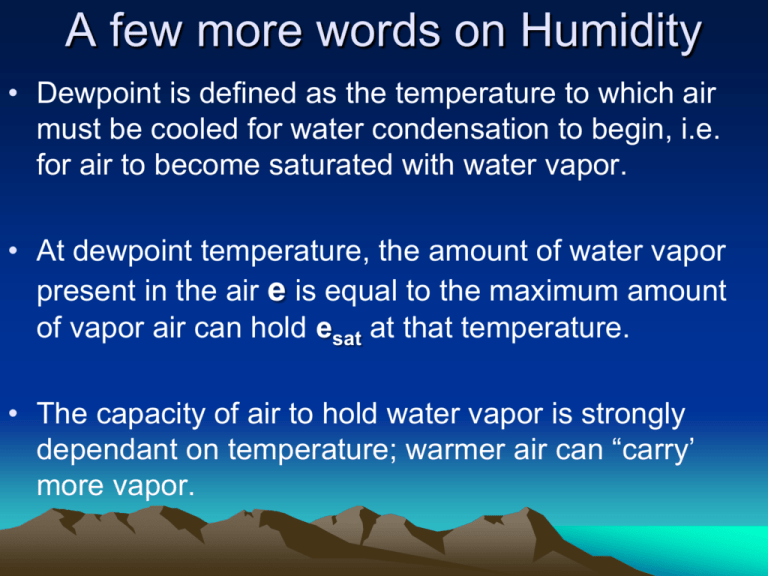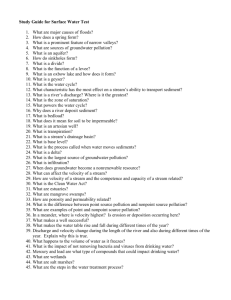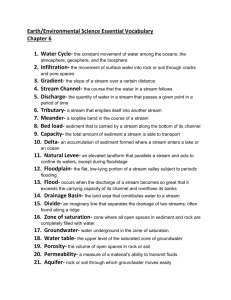Chapters 13 and 14
advertisement

A few more words on Humidity • Dewpoint is defined as the temperature to which air must be cooled for water condensation to begin, i.e. for air to become saturated with water vapor. • At dewpoint temperature, the amount of water vapor present in the air e is equal to the maximum amount of vapor air can hold esat at that temperature. • The capacity of air to hold water vapor is strongly dependant on temperature; warmer air can “carry’ more vapor. In other words • If you know from your measurements the dew point temperature, you really know how much water vapor e is in the air. • The dew point is the temperature when that much moisture is the most that air can carry. • The vapor pressure e is just the saturation vapor pressure es at the dew point temperature. A useful relation • This means that if we have some expression, or table, for determining esat at some temperature T, we can also calculate e by using the dewpoint temperature Td for T • Dew Point Temperature (Td) describes the actual amount of water vapor (e), which is the saturation value es at dew point temperature. http://cires.colorado.edu/~voemel/vp.html Freshwater Systems Streams account for 85% of sediment transport to the oceans, glaciers 7%, waves 1.5%, wind 1% Lab Hose, sand in beaker Fluvial (Latin fluvius: river) Lacustrine (lake) Sources of Earth’s water (saltwater) freshwater Longitudinal profile of a stream Tributaries Drainage Divide Stream capture, decapitation Trunk Stream Distributaries And Delta Stream Changes • Changes from upstream to downstream • Factors that decrease downstream – A. Longitudinal Profile is a side-view of a stream • From head (headwaters) to mouth of stream profile flattens out So gradient (slope) decreases downstream – B. channel roughness (grain size) also decreases downstream • Factors that increase downstream until the delta – A. Discharge – B. Channel size Base Level • Elevation below which a stream cannot erode • Local and ultimate • Ultimate usually ~ sea-level • h=0 A waterfall results from change in local base level Local change in base level affects river profiles Graded Streams • Erosion and Deposition Equal • When local conditions in a graded stream are disrupted, velocity changes. http://h2o.enr.stat • Original conditions are restored. e.nc.us/nps/What _is_NPS/agr.htm • DEMOS • Pinched hose demo, change in velocity at restrictions • Hose and sand demo: faster water is better at erosion More important definitions Stream - Sediment Terminology • Transported material is called load • Types of load – Dissolved load - ions in solution – Suspended load - fine clays, etc – Bed load Moves during flood - high velocity Sandy Portion – Saltation (bouncing) Boulders – Traction (rolling) • Capacity –maximum load stream transports • Competence – Largest particles it can move • Proportional to velocity squared Suspended load - confluence Green & Colorado Rivers in Canyonlands, Utah • Competence • Maximum particle size a stream transports • Proportional to velocity squared –K.E. velocity, increase Deposition of sediment by a stream Increase transport and erosion for a Caused by a decrease in velocity Competence is reduced Sediment begins to drop out particle size Increase particle size, increase deposition for a particular velocity • 1. Narrow valleys uplift or drop in base level • V-shaped • Downcutting toward base level • Can include rapids and waterfalls • • Straighter streams Typical of steep slopes in uplifted areas An Alluvial Fan in Death Valley Sudden drop in competence Alluvial fans Develop where a high-gradient stream leaves a narrow valley and spreads out onto a broad plain Slopes outward in a broad arc 2. Wide valleys – high suspended load –Meanders "Meandering Stream" • Cut bank and point bar • Cutoffs and oxbow lakes – • • Floodplains, either: Erosional floodplains Depositional floodplains The Water Icosahedron • Water molecule like Mickey Mouse—two positively charged Hydrogens, one negatively charged oxygen, very polar molecule, good solvent. Angle about 105o • Hydrogen bonding, two oxygens share a proton H+ in liquid water. Arrangement the water icosahedron Top Left • Hydrogen bonding increases the energy required to vaporize water. About 585 calories/gram water is released to atmosphere during condensation. Erosion and deposition along a meandering stream Discussion: Crack the whip Floodplain Levee Meanders get more extreme with time. Deposition at point bar keeps up with erosion at cutbank • Deposition of sediment by a meandering stream • Channel deposits – Point bars cover bed load as meandering stream’s channel loops move – Floodplain deposits cover point bar Natural Levees Natural Levees –form parallel to the stream channel, by successive floods over many years. Water overtops bank and slows over floodplain, competence drops, deposition occurs. • This 700 ft section of levee slid into the east side of the Mississippi River on August 23, 1983 at Darrow, in Ascension Parrish, Louisiana. The slide occurred shortly after a high water stage had receded, suggesting that toe undercutting and rapid drawdown likely contributed to the failure. Formation of natural levees by flooding Meandering Stream Flood over banks, sediment carrying water into wide area, greater drag, lower velocity, load drops Channel moves in direction of cutbank Pointbar advances as crossbed drapes Meandering Stream Cut off loops silt up; called oxbow lakes Old cut-off loop fills with mud, an oxbow lake OxBow Floodplain http://hays.outcrop.org/gallery/rivers/arid_meander?full=1 Point Bar Sequence from Meandering Stream Fines of Floodplain Crossbeds of Point Bar Gravel of bed Erosion • Incised meanders Delaware Water Gap • Meanders in steep, narrow valleys – Caused by a drop in base level or uplift of region Stream Terraces River meanders across floodplain. Base level drops, or region uplifts. River cuts into bed, cutoffs abandon large loops, leaving oxbows Stream less wide, uses narrower floodplain Old floodplain is a terrace A flight of river terraces 3. Braided Streams • Occur where bed load is very high. Often big boulders in the stream. At headwaters and near glaciers • Many channels because flow is intermittent/seasonal - old channel banks collapse in dry season , redirect flow next flood season • "mid-channel bars" between channels Deltas • Occur where stream hits slow water • Velocity, competence, bedload drop • Deposits build out into lake or sheltered sea, extending the length of the river • Consists of three types of beds Topset beds Foreset beds Bottomset beds Deltas have strata deposited in a characteristic geometry Topsets, Foresets and Bottomsets Actually much more complex: many distributary channel deposits River delta distributary channels change location with time General trend: Delta builds Seaward. If Floodwaters happen to reach the sea via a new shortcut, they flow by the shorter (steeper) path cutting a new channel, abandon old A fan-delta in a lake Part 2 - Groundwater • water found in sediment, plus narrow fractures in bedrock • Groundwater is the largest usable reservoir of fresh water available to humans, but much more in glacier ice Distribution of Groundwater •Water table is the upper limit of saturation •Variations in the water table Depth is highly variable •Varies season ally and from year to year •Shape is usually similar to surface topography Groundwater table generally follows topography Factors influencing movement of groundwater - 1 • Porosity – Volume of Pore Space • Permeability – the ability of a material to transmit a fluid through pore space Factors influencing movement of groundwater - 2 • Aquifer – a permeable rock layer or a sediment that transmits groundwater freely (such as sands and gravels) • Aquitard – an impermeable layer that hinders water movement (such as mudstone - clay) • Aquiclude (Aquifuge) solid, impermeable rock. Springs may result from a perched water table Rollie’s Well Aquifer GEYSERS •Intermittent hot springs •Water erupts with great force •Occur where extensive underground chambers exist near hot igneous rock •Groundwater heats, expands, changes to steam, and erupts Yellowstone Geyser erupting Wells To obtain a continuous supply of water, we must place a well below the water table Sometimes a pump is not needed Demo: Artesian Discussion: Quicksand Hydraulic head and urban water supplies Just Towns like an pump artesian, the water savesupmoney to their water tank at night, when electricity is cheap. Artificial artesian. Excessive Pumping of wells can cause Drawdown (lowering) of the water table Cone of depression in the water table May cause dry well Discharge exceeds recharge Saltwater contamination due to excessive well pumping Wildwood Crest Well design requires knowledge of local geology Don’t fire the town engineer! Geologic work of groundwater • Acidic groundwater dissolves limestone • Groundwater is often mildly acidic – Contains weak carbonic acid, H2CO3 which forms when carbon dioxide from the air dissolves in cloud water droplets – Groundwater becomes more acidic from decaying plants "Humic Acid" • Acid dissolves calcite in limestone, releasing CO2 gas CaCO3 + 2H+ ↔ Ca++ + H2O + CO2 (g) The reaction reverses, and calcite is deposited, if CO2 gas concentration gets high Geologic work of groundwater • Caverns • Features found within caverns – Composed of dripstone (travertine) • Calcite deposited as dripping water evaporates • Includes stalactites (hanging from the ceiling) and stalagmites (form on the floor of a cavern) CaCO3 + 2H+ ↔ Ca++ + H2O + CO2 (g) Reaction reverses, and calcite is deposited, if CO2 gas concentration gets high – Sinkhole or sinks (formed by groundwater slowly dissolving the bedrock often accompanied by collapse) – Disappearing (aka sinking) streams Karst Topography Stream incision, cave development and karst topography In Xanadu did Kubla Khan A stately pleasure-dome decree: Where Alph, the sacred river, ran Through caverns measureless to man Down to a sunless sea. Xanadu, by Samuel Taylor Coleridge Solution and Collapse Sinkholes Winter Park, Florida. 1981 Porsche Dealership and Pool Don’t fire the town’s engineer! Water weighs 8.34 pounds per gallon, and is incompressible Limestone weighs 5744 pounds/ m3 Foghorn Leghorn Pool 50x25x2 meters








